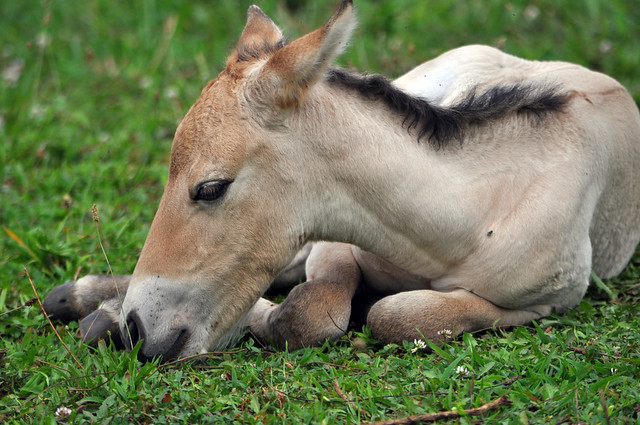Image via Doloros Reed, Smithsonian Conservation Biology Institute
It's not every day that you see a baby horse, but a newborn foal at the Smithsonian Conservation Biology Institute is even rarer. The filly born on July 27 is a Przewalski's horse, a critically endangered subspecies that's considered the last wild horse left. The filly represents a scientific breakthrough as well: It's the first of the species to be born via artificial insemination.According to the SCBI, the foal and Anne, its first-time mother, are healthy and bonding. The Przewalski's (cha-VAL-skee) horse ranged from Germany to Mongolia and northern China as recently as the 18th century. Since then, the species fell into a horrific decline, and was declared extinct in the wild in 1969 until 1996, when the species was re-listed as critically endangered when a single male was seen in the wild.That means that any captive born individual is a boon to the species. However, when working with a limited gene pool, it's important to try to keep the population as diverse as possible. Assisted breeding can thus be a help, as scientists can ensure that genetically-diverse individuals are reproducing.Image via Doloros Reed, Smithsonian Conservation Biology Institute
Anne was born at SCBI as well, but her mother was imported from Europe, which made her genetically valuable to the American population of Przewalski's horses. The new foal's father, Agi, also lives at SCBI. But as SCBI researchers and colleagues at The Wilds and Auburn University in Alabama found, artificially inseminating a wild horse isn't easy.“It seems reasonable to assume that reproduction for the Przewalski’s horse would be similar to domestic horses, but it simply isn’t the case,” SCBI reproductive physiologist Budhan Pukazhenthi said in a release. “After all these years of persevering, I can honestly say I was elated to receive the call informing me that the foal had been born. I couldn’t wait to see her! This is a major accomplishment, and we hope our success will stimulate more interest in studying and conserving endangered equids around the world.”Image via Doloros Reed, Smithsonian Conservation Biology Institute
As the IUCN details, there has been debate over the horse's original range, and whether or not the deserts where they were last seen in the mid-20th century were part of its preferred range. Regardless, the usual pressures—hunting and habitat loss due to land use and climate change—drove the species toward extinction. Additionally, Przewalski's horses faced a problem fairly unique to horses and livestock: building support to protect this particular subspecies and prevent hybridization with domestic horses was difficult because, to the average Joe, a horse looks like a horse.In recent decades, efforts to protect this unique horse have begun to pay off. A captive breeding program started with just 14 individuals has since ballooned into a population of more than 1,500 horses at zoos worldwide, with a few hundred having been reintroduced into the wild, largely in Mongolia, China, and Kazakhstan.The IUCN lists the population as trending upward, thanks to successful reintroduction programs. Still, the Przewalski's horse isn't out of the danger zone yet: a limited gene pool means breeding programs must be carefully orchestrated. And once they get into the wild, there's the constant worry that they'll hybridize with domesticated horses. But as the new foal shows, the last wild horses aren't gone yet.@derektmead


